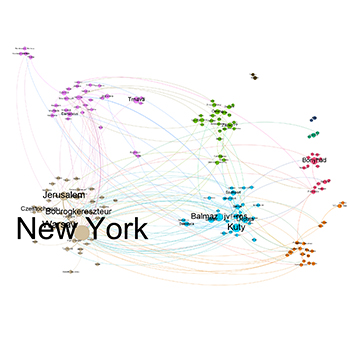From a Local Periodical to a Global Enterprise
Ha-Me'asef, 1896-1914
DOI:
https://doi.org/10.25517/jhnr.v6i1.89Keywords:
Spatial Analysis, Journalism, Jewish Studies, Late Nineteenth Century, GISAbstract
This article examines the spatial and social evolution of the network of writers in the Jerusalem-based periodical Ha-Me`asef during the years 1896-1914 as a compelling and dynamic example of transnational Jewish networks. The periodical, which was established by Rabbi Ben-Zion Abraham Koenka in 1896, was exceptional since it aspired to reach beyond the Jerusalem social circle, from where it originated, and become the center of a global communication network. At its apex, some of the leading rabbinical figures in Palestine, the Middle-East, Europe and America became active writers. The journal eliminated the borders of the isolated spatial unit, in this case Jerusalem, and suggested in its place a new perception of ‘place’, which would be part of a relational and trans-local network.
By using digital methodologies, such as geographic mapping (GIS) and network mapping (SNA), this article explores the interrelations between global expansion and local networks, and in particular the effects of globalization on the role of Jerusalem. It shows that a noticeable spatial expansion of the network coexisted at first with concealed spatial divides that separated between geographical regions, such as the Levant and Western Europe. Furthermore, it identifies social groups among the participating rabbis, and ongoing changes in the internal hierarchy of the contemporary rabbinical centers, as they were reflected in the periodical. The article shows that the success of the transnational network came hand in hand with the decline of Jerusalem as its center.

Downloads
Published
How to Cite
Issue
Section
License
A Creative Commons Attribution-NoDerivatives 4.0 (CC BY-ND 4.0) license applies to all contents published in JHNR. While articles published on JHNR can be copied by anyone for noncommercial purposes if proper credit is given, all materials are published under an open-access license with authors retaining full and permanent ownership of their work. For details please consult the Open Access and Copyright Notice.

